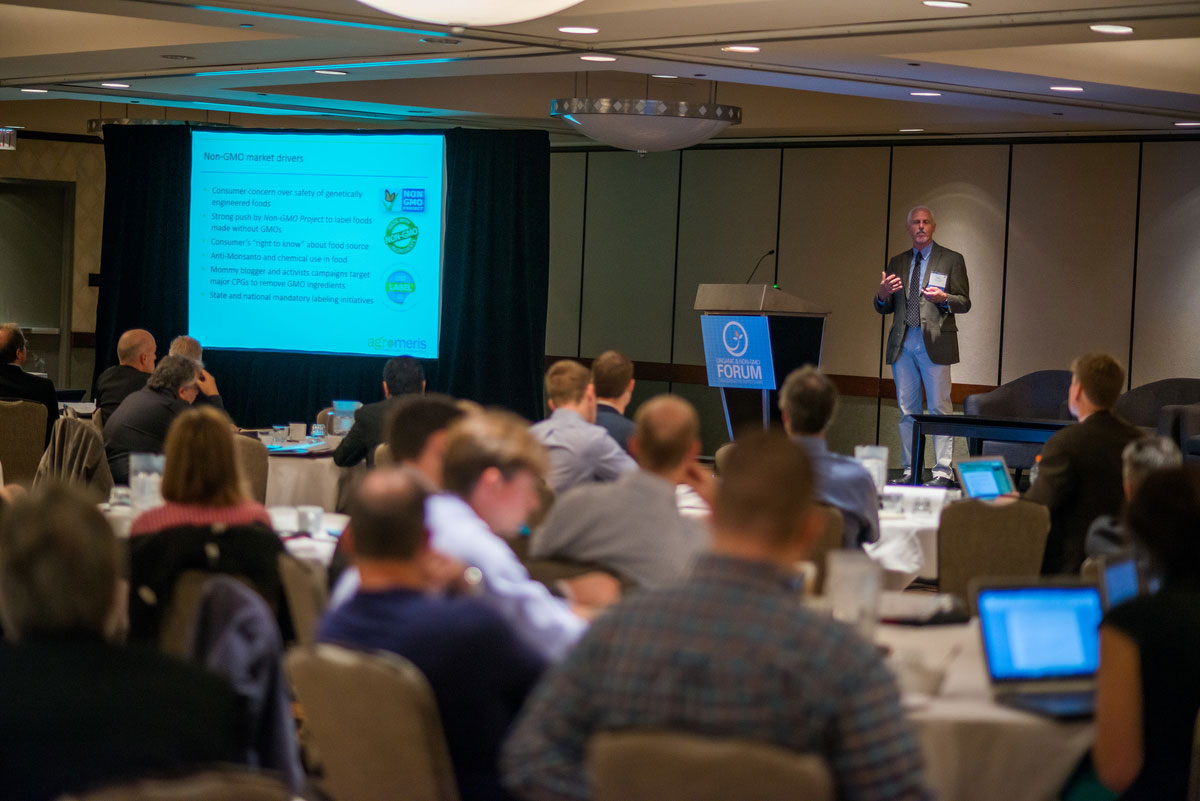Other topics covered in the one-day forum included consumer attitudes, GMO and non-GMO labeling, GMO testing, transitioning to organic farming, and coexistence of different farming methods.
Organic and non-GMO are “where the growth is”
Kellie James, CEO of Mercaris, gave an overview of the two markets.
“These trends are consumer driven,” she said. “This is where the growth is.”
But she emphasized that demand for organic exceeds the supply.
James said that organic soybeans cost $22 per bushel, and organic feed corn costs $8 to $9 per bushel, prices that are much higher than those for conventional crops.
There are 317,000 acres of organic corn and 157,000 acres of organic soybeans in the US. The leading states producing organic corn and soybeans are Wisconsin, New York, Michigan, and Pennsylvania.
“These are states that have smaller farms,” James said.
On the non-GMO side, export markets for food-grade soybeans dominate production, but James sees a growing domestic market for non-GMO feed.
Solving the supply challenges requires planning, communicating the demand, investing in segregated non-GMO and organic storage and processing, building relationships, and finding markets for crops that are being grown as part of a transition to organic.
“Go back to the farm level, and understand the processes,” James said.
Kate Leavitt, director of soybean sales at SunOpta, also highlighted the strong demand for organic and non-GMO foods.
“Organic sales in the USA have seen double digit growth, from $4 billion to $40 billion in 10 years, and 40% of consumers buy organic weekly,” she said.
Meanwhile, non-GMO food sales topped $550 billion worldwide in 2014 and are growing 15% per year. Four out of 10 consumers avoid GM foods, Leavitt said.
“Food and ag industry leaders need to respond to consumer demand,” she said.
500,000 more acres needed to meet organic demand
Peter Golbitz, president of Agromeris, emphasized that organic has become mainstream.
“Organic is becoming a major part of conventional food,” he said.
Like James, Golbitz said that creating markets for crops in transition to organic is critical.
“There is a need to develop a program for certified transitional,” he said. “Farmers need to be compensated by the buyers (for the transition).”
The markets for non-GMO and organic feed are growing but are constrained by supplies, Golbitz said.
“There is a tight supply—less than one percent of US grain is organic. There is a little more non-GMO supply,” he said.
To meet current supply needs, the US needs 500,000 more acres of organic corn and soybeans.
“We could convert one to two percent of current soybean acres to meet organic needs and 100,000 acres of corn,” Golbitz said.
He also predicted that within five years, the US will need one to two million more acres of organic production to meet future needs.
In summary, Golbitz said that both the organic and non-GMO markets are “growing and profitable.”
GMO testing and labeling
Jamie Welch, supervisor of technical support at Envirologix, gave an overview of GMO testing methods, which are primarily the protein-based lateral flow “strip” test and DNA-based PCR test.
Welch said that the strip tests are fast, inexpensive, and effective for detecting GMOs in raw grains. PCR is more expensive, but better for quantifying GMO content in a sample and for detecting GMOs in processed products.
While acknowledging that both methods have benefits and drawbacks, Welch said: “The two systems work well in conjunction and are integral parts of an identity preservation system.”
Nathaniel Lewis, senior crops and livestock specialist at the Organic Trade Association, gave an overview of organic certification and distinguished organic from non-GMO.
“Organic is non-GMO and much more,” he said, citing that organic food production also excludes chemical pesticides, fertilizers, and growth hormones, while building soil fertility, protecting water resources, and enhancing biodiversity.
Mike Rakola, founder, Rakola Public Affairs, discussed non-GMO and GMO labeling issues.
He said that H.R. 1599, the so-called “DARK Act,” which passed the House of Representatives in July, won’t pass the Senate, based on conversations he’s had with Senate staff members.
Even if the bill did pass the Senate, Rakola said that the best case scenario would be that it wouldn’t take effect until 2018.
“What is the endgame for labeling?” Rakola asked. “No one knows.”
Forum to be expanded next year
This was the first year the Organic & Non-GMO Forum was held and it was a great success according to Philippe de Lapérouse, managing director of HighQuest Group, which organized the event.
“We were delighted by the attendance at this first year event which demonstrated strong industry support,” Lapérouse said. “Without a doubt we expect to organize an expanded agenda for this event next year and look forward to bringing more producers and consumer packaged goods manufacturers and foodservice operators, into the mix of speakers and attendees.”





